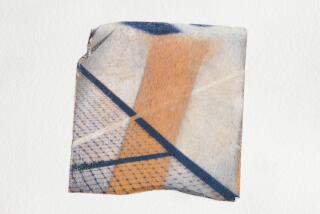THE TRYING DUTCHMAN : Tennis Taskmaster Robert Landsdorp Gets Results
- Share via
The young student--a thin, red-haired girl--groaned and breathed heavily as she sprinted from side to side, chasing tennis balls that were coming her way like missiles.
Even on a chilly autumn afternoon, thick drops of sweat rolled from her forehead and her fatigue was obvious.
But the teacher, all 6 feet, 3 inches of white-haired menace on the other side of the net, showed not an ounce of mercy. He continued hurling balls in her direction.
“Hit the ball! . . . come on,” his voice boomed. “God, how could you miss that, even a plumber can get that.”
Trying to catch her breath, the girl stood at the base line as the teacher, clad in a sweat suit with the words Square Attack written on the back, hit a dink shot that barely cleared the net.
“Get that, get that! What are you waiting for, Santa Claus? . . . Move! Move a little faster, you’re not shopping at the mall, you know.”
It was the third drop shot the girl had missed. She took a few steps toward the net and gripped her racket firmly as she waited for the next ball.
“What are you doing inside the base line? The man yelled. “I’m not going to hit you a drop shot when you know it’s coming. What are you, nuts?”
The girl sighed, rolled her eyes and stepped back.
If she was looking for sympathy, she was dealing with the wrong coach.
There’s no escaping hard work, perhaps even some torture, when you take a tennis lesson with West End Racquet Club’s god of tennis, Robert Landsdorp.
“I’ve mellowed out the last couple years,” Landsdorp said in a heavy Dutch accent. “I used to be very tough with the kids. In fact, I had a reputation for being too tough.
“I’d push them, push them, push them. I’d make them run hard and hit ball after ball after ball. I would just make lessons extremely difficult, almost to the point where they hyperventilated.”
The 45-year old Landsdorp is known to be a strict disciplinarian and perfectionist. His workouts, from a physical and mental standpoint, are demanding. It is not uncommon to see students chasing balls with tears in their eyes.
Recently a father took his daughter off the court in the middle of a lesson because he thought Landsdorp was too harsh.
“Parents shouldn’t watch when their kids take lessons,” Landsdorp said. “It’s not easy to watch your kid work.
“He was probably thinking, ‘What the hell is this guy doing to my baby?’ He told me his daughter didn’t have to take that kind of abuse. I said, ‘If you don’t like it, get out.’ ”
Few do get out--not if they take the game seriously.
Landsdorp is considered one of the best tennis pros in the area. If you don’t believe it, try to get some available lesson time in his schedule.
“He pushes you to your very limit,” said Nicholas Getz, the director of tennis at West End, who was a top-ranked junior coached by Landsdorp before playing at San Diego State University. “He’s a master at manipulating your emotions. He just tears you down and toughens you up.”
Getz saids Landsdorp hollers and stomps his feet on the court, exaggerating what an opponent might do, so students feel as though they’re playing in a tournament every time.
“It’s not easy being coached by Robert,” he said. “If you can endure the kind of pressure he puts on you, you can be a champion.”
Those who have survived Landsdorp’s tennis boot camp have had successful careers. He’s produced several champions in 20 years as a coach.
One of them is former UCLA All-American Eliot Teltscher, who is ranked No. 20 in the world. Landsdorp coached him for 14 years and for a short time worked with Australian and Italian Open champ Vitas Gerulaitis, who also won a Wimbledon doubles title in 1975.
Landsdorp has also coached numerous top-ranked juniors and collegiate players from Stanford, USC, UCLA and Georgia.
Two of his recent top juniors were Melissa Gurney and Stephanie Rehe, both ranked nationally on the Women’s International Tennis Assn. computer.
Gurney, who used to live in Palos Verdes before her father changed jobs, was ranked as high as 22nd in the world last year. The teen-ager reached the third round of Wimbledon, the U. S. Open and French Open in 1986. She also won a Virginia Slims tournament in San Diego that year.
Rehe, 18, who was ranked 13th in the world in 1986, reached the fourth round of the U. S. Open and was a Wightman Cup team member.
But those are just a couple of Landsdorp’s latest products. He’s best known as the longtime coach of teen tennis star Tracy Austin, a two-time U. S. Open and Wimbledon mixed-doubles champ. He started working with Austin, who was the top-ranked female player in the world in 1980, when she was 7 and traveled with her throughout most of her professional career.
“He teaches good strokes and basic fundamentals,” Austin said. “But he was tough (while I was) growing up. In order to take from him, you have to be strong. If you’re not strong, Robert is not the coach for you.”
Austin recalls a lesson with Landsdorp when she was about 13. He made her run so hard that she hyperventilated, but as soon as she could breathe again, he had her back on the court hitting balls.
“It sounds horrible,” she said, laughing. “It sounds like he beats kids, which is not the case. It’s just that he’s not out there to pity-pat the ball around and go whoop-de-do. He aggravates you so you can work harder. He’s a great coach and he really makes you strong.”
Now that Austin is 24, she realizes that a lot of what Landsdorp does on the court is an act to toughen up players.
“He could get an Oscar,” she said. “He really is an actor.”
Landsdorp’s wife of 13 years, Sue, agrees. She says he’s so big and overbearing that a lot of the kids and women at the club are afraid of him.
“He acts tough because he thrives on seeing kids improve,” she said. “He’s really a softy, a real teddy bear.”
The drill-sergeant act is because “if children think you’re really mad and bent out of shape, they try hard,” according to Landsdorp.
“I mean, of course I have pity, but I show no pity. You just can’t and sometimes it’s so hard to be mean because they’re so cute.”
Some of the court antics are part of the real Landsdorp, though. He really is aggressive and dominating. He says he had to be to survive in this country.
When Landsdorp came to the United States with his parents, he was 20 and did not speak English. He was not good enough at tennis to get sponsors, praise and glory that top players receive today.
“I had always just played tennis for the hell of it,” he said. “I never thought of making a living of it because in those days there was no money. Only the top eight players in the world could make a living. I was definitely not that good.”
He started playing tennis as a child in Holland. His father, a businessman, was a casual player who got him started in the game. At 16 he was good enough to play on the junior national team, and at 19 he was on reserve for Holland’s Davis Cup team.
“I didn’t know a damned thing about the game,” said Landsdorp, who claims he was a hard-court player forced to play on clay. “Not like what they know today. For instance, I didn’t even know what top spin was. I just went out and hit the hell out of the ball.”
Landsdorp held odd jobs to help the family financially and played tennis on weekends. One weekend in 1967, he played in a San Diego tournament and beat Pepperdine’s top player in the semifinal. Pepperdine’s coach offered him a tennis scholarship, which he took “for the heck of it.” His only goal was to remain first in the lineup and have a good time.
“I made sure I got my partying in,” Landsdorp said. “And that really caused problems, because at the time it was a small religious school and they didn’t even let you dance, not to mention drink.”
Landsdorp enjoyed himself, but he had to work hard because the competition was very tough. He says college tennis when he played in the ‘60s was a lot better than it is today because all the top players in the country played in college.
For instance, Landsdorp competed against Wimbledon, U. S. Open and two-time Australian Open champ Arthur Ashe, who played for UCLA, and Davis Cup team member Dennis Ralston, who played at USC and won doubles at Wimbledon in 1960. He lost to both.
“That’s like (Stefan) Edberg or (Ken) Flach and (Robert) Seguso playing in college today,” Landsdorp said. “I’m not putting down college tennis. It’s still pretty good. It’s just not as good.”
Landsdorp considered playing professionally after three seasons at Pepperdine but decided to teach after a bad experience.
“I worked my butt off practicing for a tournament and got the flu the week before,” he said. “I managed to win the first set easily, but the second set it was like someone pulled the plug. I lost in three sets. I had worked my butt off for months preparing and didn’t earn a cent. That’s when I decided it wasn’t worth playing.”
In 1970 he started teaching regularly in San Diego, mainly kids for $7 an hour. After that he was a pro at the Kramer club in Rolling Hills for eight years. Today, he’s part-owner of the luxurious West End Racquet Club in Torrance that has 20 tennis courts, pool, aerobic and weight rooms, bar and eight racquetball courts. He gets $50 an hour for his work.
Landsdorp is on the court from 9 a.m. to noon, takes a cigarette and coffee break until 1 p.m., then teaches until 6:30 p.m.
“Ten years ago, I had to do it (teach) to make a living,” Landsdorp said. “Now I do it because I want to.”
He says he’s obsessed with improving his students.
“I think I will die on the tennis court,” he said, after taking a drag of his cigarette. “My blood pressure will go skyrocket one day when I get mad and I’ll die on the court, teaching.”
His blood pressure does not rise as much these days because he has softened up some from the extremely tense, tough instructor he once was. He says it’s mainly because of his 11-year old daughter Stephanie, the thin, red-haired girl he coaches five times a week on secluded court 17.
That’s one of Landsdorp’s easier lessons. He even laughs and compliments his student, a rare incident during a lesson with Landsdorp.
“I guess it’s tough to be hard on your own kid,” he said with a smile. “My little girl has really mellowed me out.”
She, on the other hand, says he’s still tough.
“Yeah,” Stephanie said, “and if you don’t put out 100% he’ll get real upset and start to yell. Then he’ll make you run a lot until you get real, real tired.”
And that’s what Robert Landsdorp will always be known for.
More to Read
Go beyond the scoreboard
Get the latest on L.A.'s teams in the daily Sports Report newsletter.
You may occasionally receive promotional content from the Los Angeles Times.










